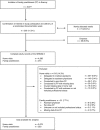The workload for home visits by German family practitioners: an analysis of regional variation in a cross-sectional study
- PMID: 30609917
- PMCID: PMC6318834
- DOI: 10.1186/s12875-018-0891-6
The workload for home visits by German family practitioners: an analysis of regional variation in a cross-sectional study
Abstract
Background: In Germany, home visits account for a considerable workload for many family practitioners, substantial rural-urban disparities are assumable with regards to home visit frequency and duration. Considering the ongoing demographic change and a rural-urban migration a significant regional difference in the provision of care is assumable. There is a lack of reliable data on the current provision of home visits and how their organisational procedures can be ensured in the future. The aim of this study was to describe and assess the average workload of family practitioners during home visits and compare their rural-urban variations.
Methods: A cross-sectional study over a period of 12 months was conducted in Saxony as part of the fifth project of the Saxon Epidemiologic Studies in General Practice (SESAM-5). Over a 1-week period, family practitioners documented every home visit and answered questionnaires about sociodemographic, organisational and clinical characteristics. According to common categorizations in empirical studies four regional groups (rural, semi-rural, semi-urban, urban) were analysed and compared by non-parametric tests: Kruskal-Wallis followed by Dunn's, Jonckheere-Terpstra and Mann-Whitney-U. Multinomial logistic regression analyses were carried out using a collection of plausible predictors to assess influences for a high frequency and a long duration of home visits.
Results: The sample included 3673 home visits conducted by 253 family practitioners. On average, 14.5 home visits were carried out per week with an average duration of almost 28 min. After comparing regional areas, the number and total duration per home visit showed significant differences between the regions: 8.2 h (rural), 7 h (semi-rural), 6.6 h (semi-urban) and 5 h (urban). The regression analyses found that a high frequency of home visits was most likely accomplished in rural regions and a long duration was most likely performed in private homes.
Conclusions: Workload of home visits is strongly associated with the regional location of the practice, leading to rural-urban disparities. Strategies to reduce regional disparities to ensure the future provision of care in the German and comparable health care systems should be discussed, e.g. by financial incentives (short-term), exploiting the potential of delegation (medium-term) and discussing the implementation of substitution (long-term).
Keywords: Cross-sectional study; Family practitioners; Home visits; Homebound patients; Rural-urban; Workload.
Conflict of interest statement
Ethics approval and consent to participate
A positive ethic vote was confirmed by the ethics committee of the Technical University of Dresden (EK 350092013) and adheres to the Declaration of Helsinki. Written consent was obtained from every participant (FP, assistant physicians, medical assistants). According to the national guideline § 15 Medical Association’s professional code of conduct of Saxony (Berufsordnung für Ärzte in Sachsen) a patient consent was not required because patient data were documented anonymously.
Consent for publication
Not applicable.
Competing interests
The authors declare that they have no competing interests.
Publisher’s Note
Springer Nature remains neutral with regard to jurisdictional claims in published maps and institutional affiliations.
Similar articles
-
[Regional Influences on Home Visits - Is Care in Rural Areas Secured in the Long Term?].Gesundheitswesen. 2022 Mar;84(3):215-218. doi: 10.1055/a-1241-4107. Epub 2020 Oct 7. Gesundheitswesen. 2022. PMID: 33027827 German.
-
Effect of the delegation of GP-home visits on the development of the number of patients in an ambulatory healthcare centre in Germany.BMC Health Serv Res. 2012 Oct 10;12:355. doi: 10.1186/1472-6963-12-355. BMC Health Serv Res. 2012. PMID: 23046512 Free PMC article.
-
Home visits in primary care: contents and organisation in daily practice. Study protocol of a cross-sectional study.BMJ Open. 2016 Feb 26;6(2):e008209. doi: 10.1136/bmjopen-2015-008209. BMJ Open. 2016. PMID: 26920438 Free PMC article.
-
Delegating home visits in general practice: a realist review on the impact on GP workload and patient care.Br J Gen Pract. 2020 May 28;70(695):e412-e420. doi: 10.3399/bjgp20X710153. Print 2020 Jun. Br J Gen Pract. 2020. PMID: 32424046 Free PMC article. Review.
-
Factors associated with the workload of health professionals in hospital at home: a systematic review.BMC Health Serv Res. 2022 May 26;22(1):704. doi: 10.1186/s12913-022-08100-4. BMC Health Serv Res. 2022. PMID: 35619075 Free PMC article.
Cited by
-
Expanding the role of non-physician medical staff in primary care in Germany: protocol for a mixed-methods study exploring the perspectives of physicians in rural practices.BMJ Open. 2022 Jul 26;12(7):e064081. doi: 10.1136/bmjopen-2022-064081. BMJ Open. 2022. PMID: 35882465 Free PMC article.
-
Task shifting to improve practice efficiency: A survey among general practitioners in non-urban Baden-Wuerttemberg, Germany.Eur J Gen Pract. 2024 Dec;30(1):2413123. doi: 10.1080/13814788.2024.2413123. Epub 2024 Oct 28. Eur J Gen Pract. 2024. PMID: 39466891 Free PMC article.
-
What are the risk factors for avoidable transitions in the last year of life? A qualitative exploration of professionals' perspectives for improving care in Germany.BMC Health Serv Res. 2021 Feb 15;21(1):147. doi: 10.1186/s12913-021-06138-4. BMC Health Serv Res. 2021. PMID: 33588851 Free PMC article.
-
Barriers and facilitators of family doctor contract services in caring for disabled older adults in Beijing, China: a mixed methods study.BMJ Open. 2023 Jun 1;13(6):e070130. doi: 10.1136/bmjopen-2022-070130. BMJ Open. 2023. PMID: 37263682 Free PMC article.
-
Regional differences in the patient population of general practices in northern Germany: results of a mixed-methods study.BMJ Open. 2020 Nov 27;10(11):e041762. doi: 10.1136/bmjopen-2020-041762. BMJ Open. 2020. PMID: 33247029 Free PMC article. Clinical Trial.
References
-
- Gonçalves J, Weaver F. Effects of formal home care on hospitalizations and doctor visits. Int J Health Econ Manag. 2016:1–31. 10.1007/s10754-016-9200-x.
-
- National Health Service . Trends in Consultation Rates in General Practice 1995/1996 to 2008/2009: Analysis of the QResearch Database. 2009.
Publication types
MeSH terms
LinkOut - more resources
Full Text Sources
Medical


